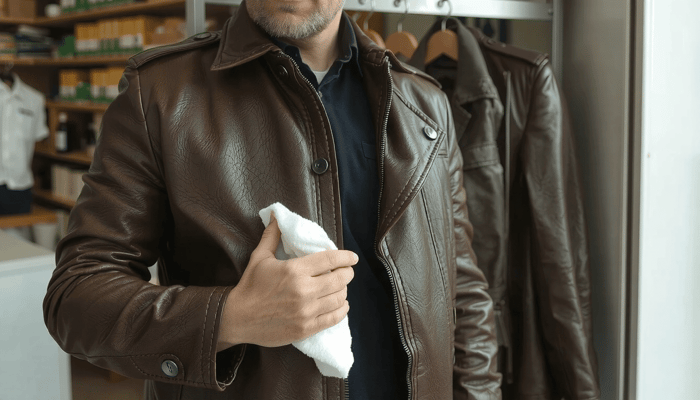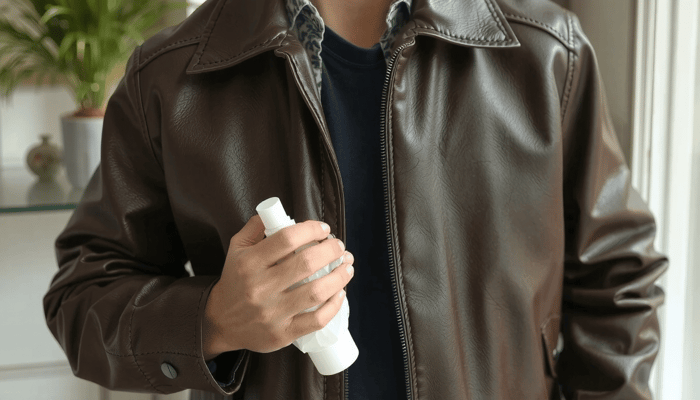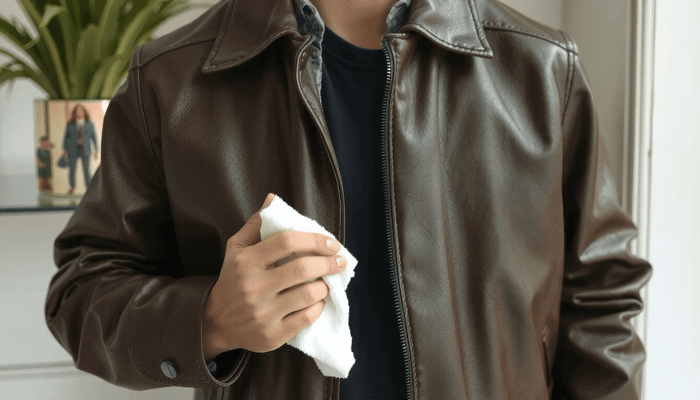How to Clean a Leather Jacket at Home: The Complete Step-by-Step Guide
 Mr. Eton Yip | 32+ Year Garment Manufacturing Expert & Founder of Eton Garment
Garment Industry
Mr. Eton Yip | 32+ Year Garment Manufacturing Expert & Founder of Eton Garment
Garment Industry
July 19th, 2025
11 minute read
A quality leather jacket is more than just wearing it. It is a long-term investment, and it serves as a piece of clothing that can last a lifetime. Feeling scared of cleaning it yourself is a natural phenomenon. We sympathize with your concerns about making unfixable mistakes.
The encouraging thing is that you can definitely learn how to clean a leather jacket at home, without causing any harm. You only need the right information, equipment, and skills.
This complete guide will accompany you in every step. We will be discussing the process of getting ready, finding your leather type, cleaning the outside and inside, staining issues, and the crucial final step of conditioning that will help in not only making the jacket shiny but it will also increase its life.

Before You Start: The 3 Important Prep Steps
Preparation is the key. Cleaning without any preparation causes the most damage. These three steps are a must-do for success.
Step 1: Find Your Leather Type
Leather is not all the same. The way you will clean it is determined by the type of leather. The common leather types used for jackets are finished and unfinished leather.
The treated or finished leather that is most common is the most popular type. It has a top protective layer that is impermeable to stains and water. The other type of leather is the unfinished leather, also called aniline or naked leather. It is totally natural meaning it has the capability to absorb water and is therefore more delicate. Suede and nubuck are both types of leather that are fuzzy and soft but they need completely different dry-cleaning processes. This guide is only for smooth, non-fuzzy leathers.
You can identify your leather type by doing a simple water drop test. Just put one drop of water on a hidden area of the jacket. If it stays on top like a bead for a while, then you have finished leather. If it soaks in rapidly and the area looks darker after that, then you have the more delicate unfinished leather.
Step 2: Get Your Supplies
Being fully prepared means the process can go smoothly. This keeps you from scrambling partway through. You probably have most of these items already.
- Soft, lint-free cloths (microfiber works great)
- Mild soap (like gentle dish soap or castile soap) OR a special leather cleaner
- A bowl of distilled or lukewarm water
- A good leather conditioner
- Cotton swabs (for spot tests)
Step 3: Always Do a Spot Test
This is the most important rule of leather care. You must always test the cleaning agent on an inconspicuous area before applying it to the leather jacket. The inside of the cuff, under the collar, or along a seam are some of the suggested places.
You can use a cotton swab to put a very small amount of your cleaning solution on it. Wait for a couple of minutes before you wipe it off. Use a clean damp cloth to wipe it off. Dry the area well before checking for any color changes, stains, or other bad effects before going ahead.
The Main Event: How to Clean Your Leather Jacket's Outside (5 Steps)
After your preparatory work is done, cleaning comes second. This step-by-step process is a piece of cake if you follow it properly. This way you will know how to clean the jacket without causing damage to it. Using this method for how to clean a leather jacket at home will give you professional results.
Step 1: Dust the Surface
Start by laying your jacket on a flat, clean surface. Use a dry microfiber cloth to gently wipe down the whole outside. Remove any loose dust, dirt, or bits. Always work from top to bottom to avoid spreading dirt onto clean sections.
Step 2: Make Your Cleaning Solution

If using soap, mix a few drops of your mild soap into a bowl of lukewarm water. You want a very gentle solution, not a sudsy bubble bath. A little goes far. The water should feel just slightly slippery.
Step 3: Gently Clean the Leather
Dip a clean cloth into your soapy water and squeeze it out well until it's just damp, not dripping wet. Too much water is bad for leather.
Wipe the jacket down in sections. Use long, gentle strokes that follow the grain of the leather. Don't scrub or push hard. According to cleaning experts at The Spruce, it's important to use a gentle touch to avoid removing the leather's natural protective oils.
Step 4: "Rinse" Away the Soap
Take a second, fresh cloth and make it damp with clean water only. Again, squeeze it out completely so it's just damp.
Go over the whole jacket and wipe it to remove any soap left on it. This step is crucial so as to avoid a dull film forming on the surface when it dries.
Step 5: Dry Your Jacket the Right Way
Use a dry, soft towel to gently pat the jacket and soak up any surface water. Don't rub.
Hang the jacket on a wide, padded hanger to keep its shoulder shape. Let it air dry completely at room temperature. This may take 24-48 hours. Be patient. Proper drying is key to good results.
Here's a crucial warning: Never, ever put your jacket near direct heat. Keep it away from radiators, vents, fireplaces, and direct sunlight. Don't use a hair dryer. Fake heat will dry the leather too fast, making it brittle and cracked.
Handling Tough Stains: A Spot-Cleaning Cheat Sheet
Sometimes general cleaning isn't enough for specific problems. This quick guide gives targeted solutions for common stains. Always spot-test these methods first.
| Stain Type | Recommended Solution & Method |
|---|---|
| Grease or Oil | Right away, sprinkle cornstarch or baking soda on the stain. Let it sit for several hours or overnight to soak up the oil. Gently brush it off with a soft cloth. Repeat if needed. |
| Ink | Dab very gently with a cotton swab dipped in rubbing alcohol. Work from the outside of the stain inward to stop spreading. Wipe with a clean, damp cloth afterward. |
| Water Spots | To remove single water spots, dampen the whole panel where the spot is with a damp cloth. This lets the area dry evenly, blending the spot away. |
| Mildew/Mold | Mix equal parts rubbing alcohol and water. Wipe the affected area with a cloth dampened in this solution. Let the jacket dry completely in a well-aired area. |
Don't Forget the Inside: How to Clean the Jacket Lining
The jacket's lining soaks up sweat and body oils, so it needs attention too. Learning how to clean the inside of a leather jacket is simple but important.
First, turn the jacket completely inside out and hang it on a hanger. You can use the same mild soap and water solution you made for the outside.
As professional cleaners suggest, be careful to use a cloth that's only damp. You want to avoid soaking the lining. Too much water could seep through and damage the leather from inside.
Focus on the areas that get the most contact. These include the collar, cuffs, and underarms. After cleaning, wipe the lining with a cloth dampened only with water to rinse. Let the jacket hang inside-out to air dry completely before turning it right-side out.
The Must-Do Final Step: Conditioning Your Leather
Skipping this step is like washing your hair without conditioner. It leaves the material weak. This is the final, crucial part of how to clean a leather jacket at home.

Why Conditioning is a Must
The cleaning process, even when gentle, can remove some of the leather's essential oils. Conditioning puts these oils back. It brings back moisture, keeping the hide soft, flexible, and resistant to drying and cracking.
How to Apply Leather Conditioner
First, make sure your jacket is 100% dry from cleaning. Don't apply conditioner to damp leather.
Put a small, coin-sized amount of good leather conditioner onto a clean, lint-free cloth. A little goes far.
Work the conditioner into the leather using small, circular motions. You'll feel the leather start to soften and see a subtle richness return to the color. Don't use too much. A thin, even coat is all you need. Pay extra attention to areas that bend and flex, like the elbows and shoulders.
Let the conditioner soak into the leather for the time the product label says. This is typically 15 minutes to an hour. Finally, take another clean, dry cloth and gently buff the whole jacket to remove any extra product and bring out a beautiful, natural shine.
Big Mistakes to Avoid (The "Do Not" List)

To keep your jacket safe, here's a clear list of things you should never do.
- NEVER put your leather jacket underwater or in a washing machine. This will cause damage you can't fix.
- NEVER use harsh chemicals like bleach, ammonia-based cleaners, or all-purpose household sprays. They will strip the finish and dry out the leather.
- NEVER use rough sponges, scouring pads, or stiff brushes that can scratch and permanently mark the surface.
- NEVER dry your jacket with a hair dryer, in a tumble dryer, or in direct sunlight. This warning against using tumble dryers is echoed by garment care experts, as intense heat is the fastest way to ruin leather.
- NEVER store your jacket in a plastic garment bag. Leather is natural skin that needs to breathe. Use a breathable cloth garment bag for long-term storage.
Knowing how to clean a leather jacket at home is a powerful skill. It saves you money on professional cleaning. More importantly, it extends the life of a treasured piece of clothing, making sure it looks its best for years to come.
For those who love high-quality clothes and proper care, exploring expertly made pieces can be rewarding. You can discover a range of premium clothing at china-clothing-manufacturer.com.
Common Questions (FAQ) about Cleaning Leather Jackets
Can I put my leather jacket in the washing machine?
Absolutely not. Machine washing is one of the worst things you can do to a leather jacket. The mix of complete soaking in water and the tumbling action will strip the leather of its essential oils. This makes it stiff, brittle, and cracked. It can also warp the jacket's shape forever. Always hand-clean using the methods described above.
How often should I clean my leather jacket?
A full, deep cleaning is only needed about once or twice a year, or when it gets visibly dirty. For minor spills or marks, it's best to spot-clean them right away. More important for routine care is conditioning. We recommend conditioning your jacket every 6 to 12 months. This depends on the climate and how often you wear it, to keep it flexible.
Can I use vinegar to clean my leather jacket?
While a heavily watered-down solution of white vinegar and water (typically a 1:1 ratio) can be used for things like removing strong smells or some types of stains, it's risky. Vinegar is acidic and can be harsh on certain leather finishes. It's always safer to use a special leather cleaner or a very mild soap solution. If you must use vinegar, a spot test on a hidden area is a must.
What should I do if my leather jacket gets wet in the rain?
Don't panic. The key is to act quickly and dry it properly. As soon as you can, use a soft towel to gently blot away the extra water. Don't rub. Then, hang the jacket on a wide, padded hanger and let it air dry completely at room temperature. Keep it away from any direct heat sources like radiators or sunlight. Once it's fully dry, apply a light coat of leather conditioner to replace any oils that may have been lost and restore its flexibility.
How can I get a musty or thrift-store smell out of my jacket?
The first step is to air it out. Hang the jacket in a well-aired area—but not in direct sunlight—for a day or two. If a smell stays in the lining, you can turn the jacket inside out and lightly spray the fabric with a 1:1 solution of white vinegar and water, then let it air dry completely. For the outside, doing the full cleaning and conditioning process outlined in this guide will also help a lot in getting rid of old smells.
Related Articles
The Definitive Manual to the WHO DECIDES WAR Jacket: Brand, Background & Style
8 minute read
July 19th, 2025
A WHO DECIDES WAR jacket is the label of the luxury street fashion brand's own design. The brand... more »
Master the Fold: Your Ultimate Guide to Folding Any Jacket Effectively for Travel & Storage
9 minute read
July 19th, 2025
The proper folding technique is a must-have for any traveler or person who wants their closet... more »
How to Wash a Heated Jacket: The Complete Guide to Safe Cleaning (2024)
11 minute read
July 19th, 2025
In the face of extremely cold weather, a heated jacket can revolutionize your life. But the next thing... more »
Are Heated Jackets Safe? The Definitive Guide to Technology, Risks, and Safe Usage
10 minute read
July 18th, 2025
Let's get straight to the point. Yes, heated jackets are very safe when you buy them from trusted... more »
What to Wear with a Jean Jacket: The Ultimate Guide for 2025
12 minute read
July 18th, 2025
The jean jacket is a real fashion icon. It's timeless and adaptable, a necessary element in every... more »

